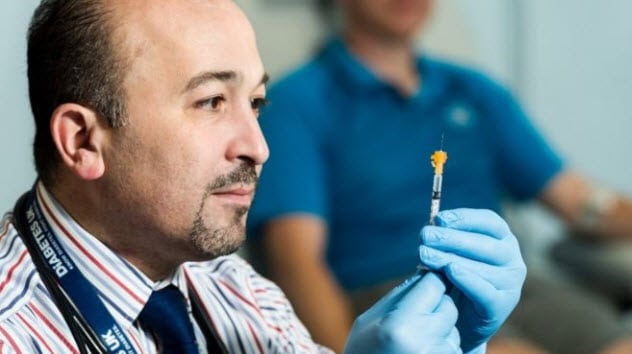 Mysteries
Mysteries  Mysteries
Mysteries  Creepy
Creepy 10 Scary Tales from the Middle Ages That’ll Keep You up at Night
 Humans
Humans 10 One-of-a-kind People the World Said Goodbye to in July 2024
 Movies and TV
Movies and TV 10 Holiday Movies Released at Odd Times of the Year
 Politics
Politics 10 Countries Where Religion and Politics Are Inseparable
 Weird Stuff
Weird Stuff 10 Freaky Times When Famous Body Parts Were Stolen
 Miscellaneous
Miscellaneous 10 Interesting Things Manufacturers Stopped Making and Why
 Gaming
Gaming 10 Funny Tutorials in Games
 History
History 10 Fascinating Little-Known Events in Mexican History
 Facts
Facts 10 Things You May Not Know about the Statue of Liberty
 Mysteries
Mysteries 10 Devastating Missing Child Cases That Remain Unsolved
 Creepy
Creepy 10 Scary Tales from the Middle Ages That’ll Keep You up at Night
 Humans
Humans 10 One-of-a-kind People the World Said Goodbye to in July 2024
Who's Behind Listverse?

Jamie Frater
Head Editor
Jamie founded Listverse due to an insatiable desire to share fascinating, obscure, and bizarre facts. He has been a guest speaker on numerous national radio and television stations and is a five time published author.
More About Us Movies and TV
Movies and TV 10 Holiday Movies Released at Odd Times of the Year
 Politics
Politics 10 Countries Where Religion and Politics Are Inseparable
 Weird Stuff
Weird Stuff 10 Freaky Times When Famous Body Parts Were Stolen
 Miscellaneous
Miscellaneous 10 Interesting Things Manufacturers Stopped Making and Why
 Gaming
Gaming 10 Funny Tutorials in Games
 History
History 10 Fascinating Little-Known Events in Mexican History
 Facts
Facts 10 Things You May Not Know about the Statue of Liberty
10 Uplifting Stories To Get You Through The Week (9/16/18)
We thought that Listverse could use a bit more positivity and show that not everything has to be doom and gloom. In this list, we take a look at 10 news items meant to lift your spirits and inspire. Of course, if you prefer peculiar to positive, check out the offbeat list here.
We have a few feel-good stories about different communities (not all of them human) coming together to help those in need. We also look at some positive medical news and learn about exciting new discoveries made by archaeologists. Lastly, we cover some long-overdue recognition for Jocelyn Bell Burnell, one of the most important female scientists of the 20th century.
10 Largest Ocean Cleanup Project Gets Underway
One of the most ambitious environmental ventures in history began this week as members of The Ocean Cleanup deployed their first system designed to collect floating trash. It is destined for the Great Pacific Garbage Patch, and project leaders are hopeful that they will be able to collect 50 percent of the rubbish every five years.
All the plastic and other garbage floating in the waters gets carried by currents to ocean gyres. There are five major gyres in the world—two in the Pacific, two in the Atlantic, and one in the Indian Ocean. They all have large garbage patches. Eventually, The Ocean Cleanup plans to target all of them, but for now, they are concentrating on the biggest one. Located between Hawaii and California, it is also known as the Great Pacific Garbage Patch.
The device used for cleanup is a 600-meter-long (2,000 ft) floating barrier that looks like a giant pool noodle. It has a 3-meter-long (10 ft) skirt hanging beneath it underwater. When it is deployed, it will form a U-shape as it is carried by the winds and waves. The device will trap plastic and other trash floating on the surface but, crucially, allow fish and other sea life to swim underneath it. Boats will then collect the garbage and take it to be recycled.
The system was deployed last Saturday off the coast of San Francisco for a two-week test run. Afterward, it will be towed 1,000 nautical miles to the Great Pacific Garbage Patch where it should be able to recover around 50 tons of plastic per year. If it works, The Ocean Cleanup plans to deploy 60 more systems, even larger than this one.[1]
9 Sports Team Gets New Canine Mascot

A stray dog has found an interesting new home as the “assistant coach” of a Paraguayan football team.
It all began when the animal started hanging around the grounds of Monumental Rio Parapiti, a stadium in Pedro Juan Caballero where second-tier side Club Sportivo 2 de Mayo plays. One day, she approached head coach Carlos Saguier while he was eating and he gave her a piece of his empanada. She has been by his side ever since.[2]
The team named the animal Tesapara. She now lives at the stadium and serves as the “guardian of the club.” She accompanies Saguier on the pitch, in the corridors, and in his office. She watches all the action on the sidelines and even takes part during training.
8 Promising New Drug For Diabetes

Trials for a new diabetes drug hailed as “groundbreaking” have started in Wales. The medication helps people with type 1 diabetes regrow cells that produce insulin.
It is far too early to come to a definitive conclusion about the drug, but the first human tests have proven to be promising. Two people who suffer from the condition have been dosed and monitored. They experienced no side effects over a period of 72 hours.[3]
Currently, around 90 percent of the 19,000 Welsh people with type 1 diabetes have less than 5 percent of insulin-making cells left. They need regular insulin shots because their bodies can no longer produce the hormone.
Now, researchers from Cardiff and Vale University Health Board want to expand the trial to 10 people and are searching for eight more volunteers. It is important that they have had diabetes for more than two years. In that time, the disease would have stopped the pancreas from producing beta cells that make insulin. That way, it is easier to observe if the drug is truly helping with cell regrowth.
7 Dog Helps Overturn 50-Year Conviction

An Oregon man sentenced to 50 years in jail in 2017 for child sexual abuse walked away free after a dog he allegedly killed turned up alive and well.
Joshua Horner was convicted last year. However, the Oregon Innocence Project took on his case after detecting “several red flags” in the evidence presented at trial.
One piece of testimony from the accuser said that Horner threatened to kill her animals if she went to the police. He then shot her Labrador in front of her to show that he was serious. However, investigators from the nonprofit legal organization tracked the dog down and found Lucy the black Lab alive and well with a new owner in Gearhart.[4]
The Oregon Court of Appeals freed Horner in August pending a new trial. However, the second trial was canceled and the judge dismissed the case. Since Lucy was found, the complainant has avoided meetings with the district attorney’s office.
6 Necropolis Unearthed In Egypt

Over 800 ancient tombs have been discovered in a necropolis buried under the sands for thousands of years near the village of Lisht south of Cairo.
The existence of the cemetery was known, mostly because it is marked by two pyramids at the northern and southern ends. However, most of the tombs remained a mystery to scientists until now.
A joint venture between the Egyptian Ministry of Antiquities and the University of Alabama–Birmingham led to the discovery of 802 tombs in a single field season. They are roughly 4,000 years old, dating to the Middle Kingdom.[5]
Unfortunately, looters got to most of the tombs before archaeologists. In fact, it was satellite images of looting pits that originally turned the scientific team on to the exact location of the necropolis.
Even so, Egyptologists are confident that there is still plenty of information left to uncover about the health, economic, and social statuses and mortuary practices of the ancient Egyptians. More importantly, the people buried there were likely once residents of Itjtawy, the as-yet-undiscovered city which served as capital of the kingdom for almost 300 years (some sources say over 400 years).
5 Lost Narwhal Adopted By Beluga Whales

There are several species of whale which are a common sight in the Saint Lawrence River, but narwhals are not one of them. And yet researchers from the Group for Research and Education on Marine Mammals (GREMM) have reported multiple instances of the same narwhal swimming in the river over the past three years. He is not alone. In fact, it seems that the narwhal has integrated into a pod of beluga whales.
Based on the size of its tusk, the cetacean appears to be a juvenile male. It is not uncommon for young whales to venture into strange habitats. Being social creatures, they try to make friends with boats or swimmers, sometimes with fatal consequences. This time, it seems the narwhal has found a group which is accepting of his peculiar appearance.
The latest drone footage shows that the wandering juvenile is part of a pod of approximately 10 belugas. The animals swim closely together, often rolling and rubbing against each other.
They appear to interact the same way with the narwhal as they do with each other, suggesting that he has been adopted as a member of the group. In turn, the narwhal has started displaying behavior typical of belugas such as blowing bubbles.[6]
4 Boy Makes Astounding Recovery From Skewer Through Head

Last Saturday afternoon, 10-year-old Xavier Cunningham was playing in his tree house at his home in Harrisonville, Missouri, when he was attacked by yellow jacket wasps. Trying to get away, he fell out of the tree and landed face-first on a meat skewer, which went straight through his head. Incredibly, the sharp spike missed all vital components, and following successful surgery, Xavier is expected to make a full recovery.
The boy was taken to Kansas University Hospital where a team of doctors managed to remove the rod after several hours. The skewer had avoided the eyes, brain stem, spinal cord, and blood vessels despite penetrating 15 centimeters (6 in) into the skull. This gave hospital staff the time necessary to call in expert surgeons for the procedure.[7]
One additional obstacle was the fact that the rod was square instead of rounded, thus requiring extra attention toward the sharp edges. Endovascular neurosurgeon Koji Ebersole described the event as “one in a million.”
3 Community Comes Together For Keryluke Family

Brent Keryluke from Red Deer, Alberta, Canada, refurbished a 1973 Pontiac Parisienne in the hopes of one day passing it down to his children, Arielle and Liam. Unfortunately, Brent and his wife, Nicole, died in a motorcycle accident back in May, leaving the kids in the care of his parents, Ben and Marilyn. The elderly couple was struggling to make ends meet, so they made a tough decision—they had to sell the car at auction.
The sad story of the Kerylukes was heavily covered in local media, and the community came to the auction in full force. Ben was hoping to get $14,000 for the car, but it sold for $29,000 to Rod McWilliams of Red Deer Motors. He then immediately donated it back to be sold again.
Danny Fayad of Edmonton paid $30,000 for the Pontiac the second time around and then donated it once more. It was sold for $20,000 the third time to Bob Bevins of Bulldog Metals who gave the car back to the Keryluke family.[8]
Besides the bids for the cars, other community members pledged their own donations. They topped $100,000, and the Kerylukes got to keep the Pontiac. The auction went viral on social media, and more donations are still pouring in.
2 Archaeologists Discover Oldest-Known Human Drawing

Archaeologists found what they believe to be the earliest-known drawing made by Homo sapiens on a stone flake in a cave in South Africa. After seven years of study, they concluded that the markings were made by a human with an ocher crayon roughly 73,000 years ago.
The piece of stone was found by chance in Blombos Cave in 2011 by Luca Pollarolo, a researcher from the University of Witwatersrand in Johannesburg. He was cleaning dirt and ash off other artifacts when he noticed the rock.
It had curious markings which appeared too odd to be natural. They were six straight, almost parallel lines intersected by three curved lines. He contacted colleagues from Norway and France to help establish the origins of the strange illustration.
Using an electron microscope, they were able to determine that the lines were drawn on the stone with a natural pigment called red ocher. They made multiple recreations using primitive brushes and crayons and found that the markings matched an ocher crayon tip 1–3 millimeters (0.04–0.12 in) thick.[9]
Current debate rages over whether the drawing was intentional or not. The smooth surface of the flake suggests that it was once part of a larger rock, perhaps a grindstone. If this is the case, other archaeologists argue that the markings could have been created unintentionally during the grinding process.
1 Recognition For Jocelyn Bell Burnell

Fifty years ago, Jocelyn Bell Burnell was a student learning astrophysics at Cambridge. Under the guidance of her thesis supervisor, Antony Hewish, she discovered the first radio pulsars. For this, Hewish won the Nobel Prize in Physics in 1974. Bell Burnell didn’t win anything because she was a research student.
This year, she received the Special Breakthrough Prize in Fundamental Physics in recognition of her achievement. It came with a $3 million cash prize which Bell then donated to help minority students become physics researchers.
Bell Burnell’s snub by the Royal Swedish Academy of Sciences has been criticized over the decades by many scientists, but the organization remained steadfast in its decision. The Breakthrough Prizes are awarded by a not-for-profit organization founded by Russian physicist and entrepreneur Yuri Milner. The chair of the organization’s committee, Edward Witten, described Bell Burnell’s discovery as “one of the great surprises in the history of astronomy.”[10]
The Northern Irish astrophysicist was presented with a check for $3 million, but she said she is donating it to the UK’s Institute of Physics. Specifically, it will be used to provide scholarships for groups which are underrepresented in the field.
As far as Bell Burnell is concerned, she is fine with being snubbed 50 years ago. According to her, once you win a Nobel Prize, you don’t get anything else ever again. This way, she has a party almost every year for another award or distinction she has received.
Read more uplifting stories you might have missed on 10 Uplifting Stories From The Great Depression, and 10 Uplifting Stories Of Prison Guards Who Were Rescued By Inmates.








